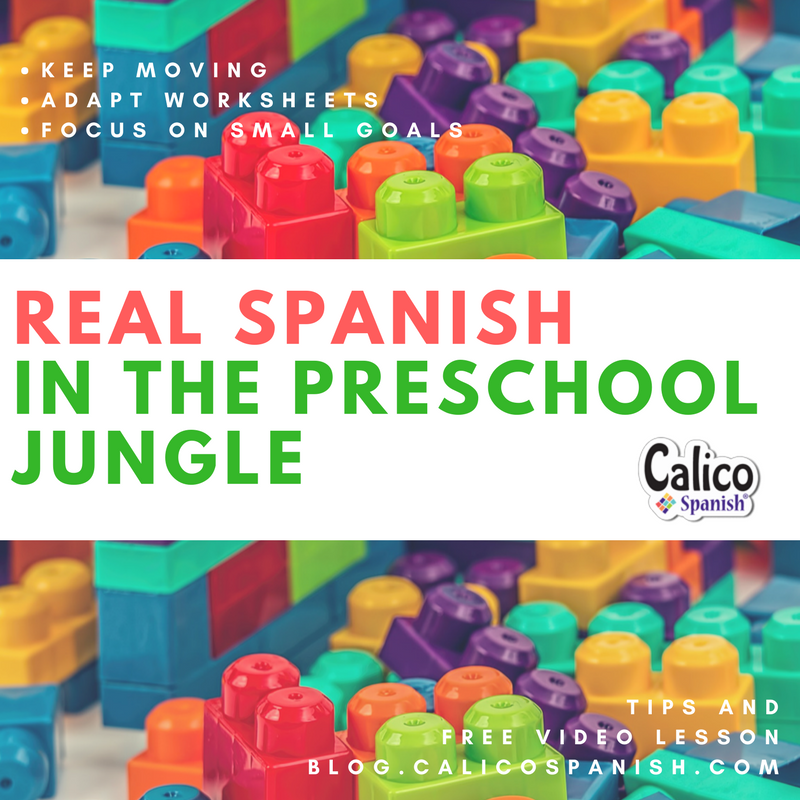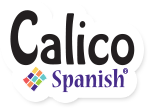Real Spanish in the preschool jungle? Yes.
Once upon a time, I thought I’d figured out how to teach elementary Spanish. Then, they asked me to teach preschool.
 Preschool is a different sort of animal. Standing in a line is a fluid concept. Rules my son’s 3-year-old class worked on last year:
Preschool is a different sort of animal. Standing in a line is a fluid concept. Rules my son’s 3-year-old class worked on last year:
– We do not lick the wall.
– We do not lick our friends.
I kid you not. Preschool is a jungle. But it’s a precious jungle. It’s one where the kids come right out and ask me, “But can’t you talk normal?”
How do you teach Spanish in this jungle? Can you teach real Spanish in the preschool jungle? Yes. And though the sweet spot for Calico Spanish Stories is really from ages 5 to 9, it works quite well in preschool, too; let us take a moment to show you how.
– Follow us on Twitter –
Cut the time.
Sometimes, in Calico Spanish Stories Level C, for example, you’ll find a lesson plan full of rich activities that you can’t effectively accomplish in less than 30 to 40 minutes. Preschoolers cannot handle that much. You’ve got to break it down. I used to think the preschool department was crazy to give me only 15 minutes. Then I discovered 15 minutes was perfect. One problem though: I only had 15 minutes per week. My ideal schedule: 15-20 minutes every day. Maybe 10-15 minutes twice a day. Tossup as to which is better.
– Like Calico Spanish on Facebook –
Move. In every single activity.
My biggest fails and most bored stares and “when is this over?” whines have happened when I tried “sit and watch the video” in my lesson plan. These children aren’t made to sit still! In every activity in the lesson plan, figure out a way they can move some part of their bodies. These are examples of tips we incorporate in our Stories lesson plans:
- When you hear the word saltar in the video story, jump!
- Play Matamoscas: a fly-swatter, running game that’s high-energy.
- Walk around the room finding all the things that are a particular color, or big/small, etc.
- Pass out vocabulary flash cards and ask children to listen for the word on their card and wave it (even my preliterate preschoolers can remember what word is on their card).
In short, get moving!
– Follow us on Instagram too! –
Ignore or adapt activity sheets.
It’s tough to find an effective “worksheet” for Spanish class at all, much less for very young children who can’t read or write. However, we’re pretty proud of the activity sheets we’ve developed for Stories (you can see many and download/print them in your 7-day free trial!). But some of ours can’t be done by preliterate children, either. For the ones that aren’t adaptable, simply ignore them. However, many are achievable as they’re written, and many more are easily adapted for young preliterate learners (see a photo example on our Instagram). We actually did a separate blog post on that, and it includes a free activity sheet download.
Introduce a child you love to a lifelong journey of speaking real Spanish to real people. Click the red button to experience it FREE.
Set and focus on SMALL goals. Then repeat.
If you don’t speak Spanish, you don’t have to be told twice that the smaller the goal, the better. But for those of us who do speak it, often we forget just how many times or how slowly we need to hear a particular word in context before we can incorporate it in communication. It’s a lot of times.
This means that all learners, and especially preschool children, need very, very small goals. To illustrate what we mean, we’ve taken some snippets of our Video Stories and put them together into a special preschool lesson. Note that this lesson isn’t an example of what’s in our Stories curriculum- to see that, you really need to experience your free first seven days of learning. Our Video Stories follow a comprehensible story plot, and then the lesson plans are where children are asked to focus on goals and complete them.
In this preschool lesson video, there are two goals. Only two. 1: Greet someone with “hi.” 2: Say your name. That’s it. Try it out with the young children in your life – can your learners greet someone in Spanish and answer the most frequent phrase they’ll hear when a Spanish speaker finds out they’re learning Spanish: “What’s your name?”
(Okay, it’s not scientific research, but really, this is the phrase every Spanish speaker uses to “test” my kids on whether or not they actually “speak” Spanish.)
Here’s the lesson:
What do you think – can your learners accomplish these small goals in Spanish today?







No Comments